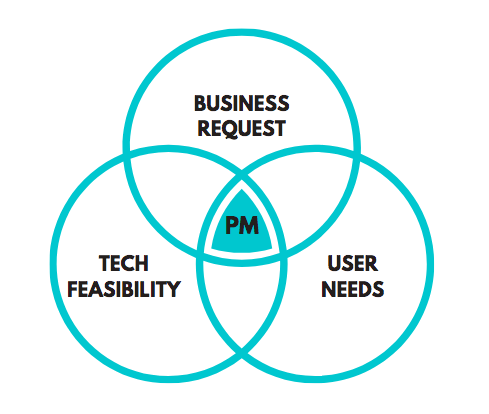Every software engineer should develop a product thinking mindset. It is important for engineers to speak up and voice their product opinions and ideas.
This article is not a guide for how anybody can become a Product Manager (that article is here).
This article is for software engineers to understand the importance of developing a product mindset.
In fact, it is imperative for everyone to develop a product thinking mindset. With that in mind, I have kept this article free from engineering jargon. This article is intended to help anyone develop a product thinking mindset.

Engineers are blessed with a lot of knowledge that can be really valuable to the development of a great product.
Software developers already know the technical aspects, if they can also understand the product aspects, they can become a great asset to the overall product development process.
Engineering a Product Mindset
Product thinking is a crucial skill for developers.
Software engineers can follow these steps to contribute more to the product development life cycle.
- Think Like a Product Manager
- Incorporate Design Thinking
- Develop User Empathy
- Be the Solution, Not the Problem
- Have a Can-Do Attitude
- Don’t be Afraid to Speak Up
- Step Out of the Comfort Zone
- Influence Without Authority
Product Thinking Mindset – Detailed
It is important for developers to play an active part in the entire product life cycle, and not just the software development life cycle (SDLC).
Think Like a Product Manager
Product Managers think about the product, about what the customer wants, about what they can do to beat the competition.
Developers can build a product mindset by doing the following tasks –
- Research the competition
- Come up with innovative ideas on how to beat the competition
- Speak up and voice those ideas
- Take full ownership of the product
Many great products fail because the development team and product teams are not in sync.

In three years, every product my company makes will be obsolete. The only question is whether we will make them obsolete or somebody else will.
Bill Gates
The development team should actively strive to continuously make the product better.
The development team, along with the product team, are equal owners of every product.
Incorporate Design Thinking
An engineer may develop a highly efficient product that does not solve any use case.
While a Product Manager can design an inefficient product that does solve a real use case.
It is important to solve for the use case.
Many developers tend to over-engineer things and lose focus of the big picture.
Over optimizing for an edge case may be of no value to a customer.
It is important to have a sense of why something is being designed, and not why something being engineered.
Design is a funny word. Some people think design means how it looks. But of course, if you dig deeper, it’s really how it works.
Steve Jobs
Design thinking is one reason that makes Elon Musk a great Product Manager.
Develop User Empathy
Understand why a product needs to be built in the first place.
Ask the right questions.
Engineers can also focus on the following steps to develop the crucial skill of user empathy –
- Understand the target audience
- Embrace the Kano Model (covered later)
- Get direct user feedback
- Don’t fall into the marginal utility trap
Instead of focusing just on how to build a product, developers should also focus on why a product is being built in the first place.
Be the Solution, Not the Problem
Many software developers tend to present reasons for why something cannot be done.
While that is valuable feedback and is necessary, engineers should also present an alternative.
A Product Manager is generally in the difficult spot of trying to convince a group of developers why something needs to be built.
Instead of simply telling the Product Manager why something is difficult or not possible, the developers should help the Product Manager and think of the entire team as one one unit.

Don’t make the Product Manager feel that he or she is the odd one out.
Have a Can-Do Attitude
Many scrum teams tend to say that they cannot do a particular task because they have a million other tasks pending.
Something that is even more common is hearing that something cannot be done when it is not a part of the original product backlog.
While both arguments may be valid, it is important to not let the process become a bottleneck to the product.
A process is established to build a great product, and not to be an obstacle to product development.

Developers should have a can do attitude and be willing to take on any and every task. This multi tasking is essential to product management.
Proactively identify opportunities and grab them.
Learn how to grab opportunities like Warren Buffett.
Don’t be Afraid to Speak Up
Many engineers have great ideas but are shy to speak up.
Some developers think that their job is to just implement what the Product Manager is telling them.
That cannot be further from the truth.
In reality, a good Product Manager always wants constructive feedback and fresh ideas from all stakeholders.
Learn how to communicate like a Product Manager.
Getting feedback and ideas from developers is generally the best case scenario. This is because nobody understands the product technical aspects better than the development team.
Step Out of the Comfort Zone
Learn the essential skills of product management.
Also understand the tools that are used in product management and project management.
This article does not say that an engineer should become a Product Manager. If a person likes being an engineer, then he or she should definitely continue in that profession.
However, if someone is looking to switch, here is a helpful article on how to become a Product Manager.
You may also like to see the list of top 9 product management courses.
Influence Without Authority
Learn how to influence without authority.
There may be situations where a junior developer may have a great idea but nobody may be listening to him or her.
That’s ok. It is important for the junior engineer to not get upset. Instead, it is important to remain calm and try different methods to get your ideas across.
In our professional lives, everyone comes across a variety of stakeholders.
It is important to respectfully learn from everyone. At the same time, we should not be afraid to respectfully convey our thoughts as well.
Product Mindset Video
Check out this video explanation on how to develop a product mindset.
Developing a thinking product mindset is essential for all teams (engineers, quality testers, and last but not the least, product managers!).
In this video, I have given a very detailed overview of the definition of the ‘Product Mindset’. I have also gone over all the concepts covered in this article.
I also use examples to help explain each topic holistically.
Kano Model
The Kano Model is a beautiful illustration of user satisfaction versus product implementation.
At a very simple level, this model depicts the natural human tendency to take things for granted.
Let us consider a new product innovation that simply amazes the market.
People line up outside stores to buy the product.
Everyone posts on social media about this latest produc innovation.
This new product embodies the concept of a product thinking mindset.
But, what happens over time? The dynamics of the product life cycle kick in.

The features that ‘delighted’ the market have a very short life.
Competition catches on to those features.
Everyone starts incorporating those delightful features into their products.
Over time, those delightful features become basic needs.
Now, the customer base expects every new product to have those ‘delightful features’ as a bare minimum.
The benchmark is thus raised.
Constant product innovation requires that developers understand that new features that delight the market are short lived. And new features need to be constantly churned out.
Product Thinking Mindset PPT
Here is a detailed PowerPoint presentation on the importance of developing a product mindset.
It is important for every software engineer to try and understand the concept of product thinking.
In the presentation above, some very important examples have also been covered.
In addition to covering some well known examples, the presentation also clearly defines the most important concepts of the product mindset framework.
The above presentation also includes quotes from great inventors like Steve Jobs and Bill Gates to drive home the concept of product thinking.
A classic example that illustrates the product mindset, specifically design thinking, is the iPhone vs Nokia example.
Product Thinking Mindset Example
The original Apple iPhone was launched in 2007.
Do you know what else was launched in 2007? It was the Nokia N95.
Take a moment to just look at the pictures of the two phones below.
Just analyze the two pictures.
What do you see? Does it look like that two phones were both launched in the same year? It is unthinkable right now to call the phone on the right a worthy competitor to the phone on the left.
But, it is easy to forget history.
Back in 2007, the Apple iPhone was the underdog, the challenger to the dominance of Nokia and Blackberry.
The Apple iPhone did not have a keypad and so many other things that were taken for granted.

There was a lot of criticism initially for the Apple iPhone.
Many people said that the phone is too simplistic and lacks basic features.
There was no micro SD slot, there was no Bluetooth, etc. The list of criticisms was endless.
But guess which phone defined the future and continues to do well? No prizes for guessing.
Yes, all those criticisms may be valid and the iPhone may have been technically inferior when compared to other phones.
But, that is not the point here.
Apple iPhone – Delighter
The point here is to be a ‘delighter’ as per the Kano Model and to capture the customer’s imagination.
Look at the pictures of the two phones above.
Only one phone looks like it is from the future.
The Nokia N95 was more of the same. It had a keypad, a slider and far too many slots.
The iPhone was simple, elegant and clean.
There was no way for Apple to have known that the product would have been a success. On the contrary, there were higher chances of a spectacular product failure.
But, fear of failure should never deter a product launch.
Apple did its market research, and launched what it thought was a great product.
And customers agreed wholeheartedly!
Product Mindset – The Sweet Spot
The product mindset is the central point in the journey of a product.
The product mindset sits at the intersection of business requirements, technical feasibility and meeting the user’s needs.

Also, the product thinking mindset is not limited to just the product management team.
It is also not limited to even the project management team.
The product mindset should be embraced by everyone.
The development team, the quality assurance team, the sales team, the marketing team, etc.
It is a great window into into the world of product management.
This product thinking helps a person go to the root cause of the ‘why’ behind any product.
Product thinking can be incorporated in everyday tasks like coding, fixing bugs, clearing the backlog, etc. Every action should be a small step in the overall product journey.
Engineers that develop this mindset are of immense value to the product mangement team.
Imagine a feature or an idea proposal by the development team to the product team.
What do you think the product team’s reaction will be? I can bet that the product team would be happy to receive the suggestion from the development team.
And the reason is simple.
If an idea comes from the development team, there is a good chance that the technical feasibility factor has already been accounted for.
Engineering a Product Thinking Mindset – Conclusion
At the end, it is important for developers to realize that they have a lot of knowledge that they can, and should, contribute towards the product development life cycle.
Every Product Manager considers himself or herself lucky if they have a development team that actively participates in the product designing and brainstorming sessions.
A Product Manager is always on the lookout for product enhancement and improvement ideas. If those ideas come from engineers, the Product Manager really appreciates them because an engineer is more likely to have thought of the technical feasibility of an idea.
Therefore, ideas from the engineering team can bring about a significant qualitative improvement to the overall product feature set.
Here is a good article on this topic.
Subscribe to my newsletter for the latest updates. You can also follow me on Twitter.